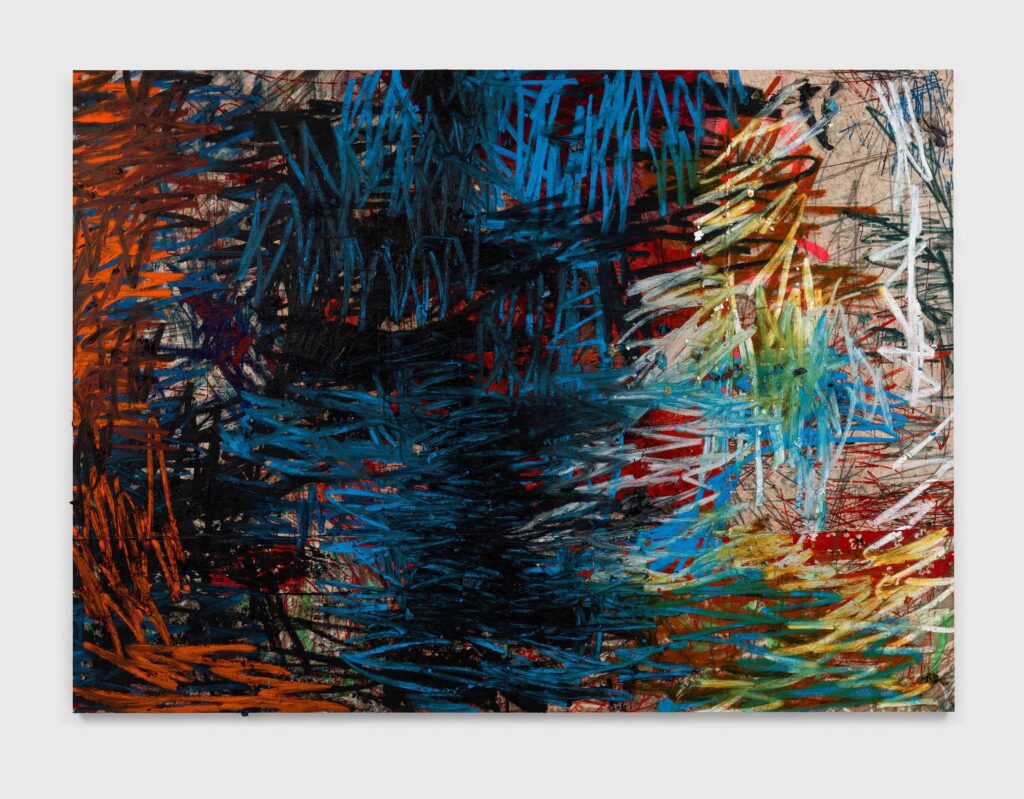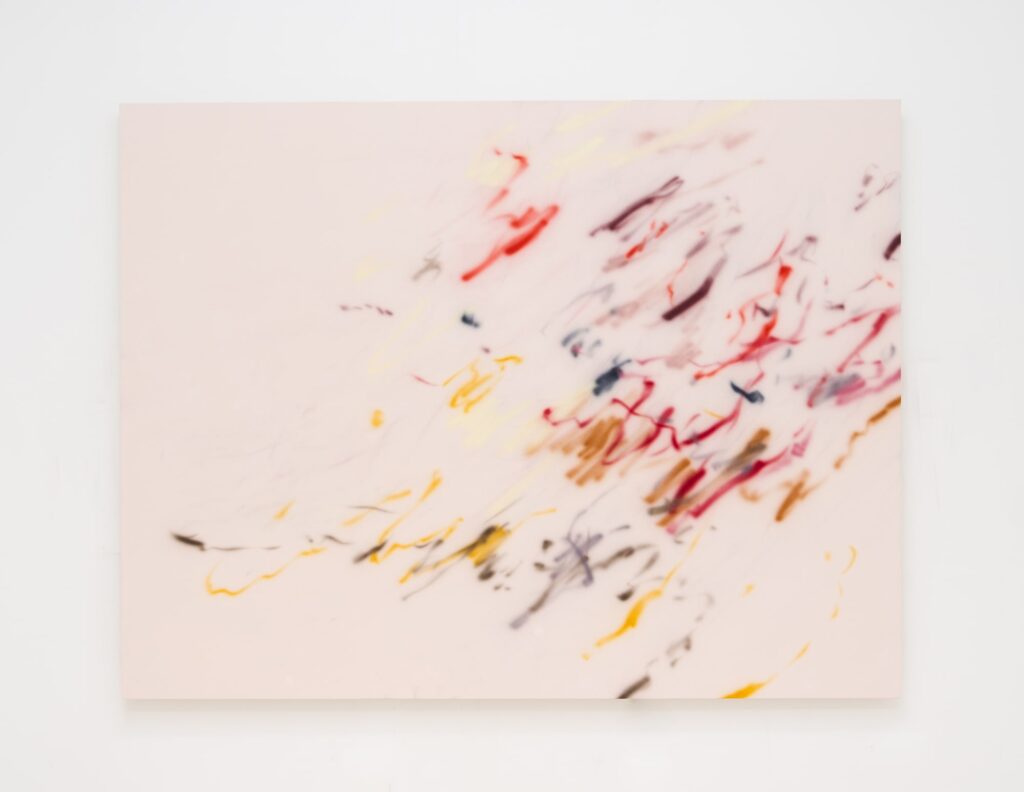
Jiayun Chen: tat skin slip tongue/塔皮滑舌
Orlando, Los Angeles, US
So, what is mark-making? Various strokes, dots, lines, textures, and patterns are drawn or painted loosely, controlled, or expressively, imbuing the canvas with the artist’s signature. This act sits between painting, drawing, and writing, using traces to build a composition. This unconventional application can occur with various media, ranging from oil paint to pastels and more. Characteristics of this approach are that it is a composition that can be read in an almost rhythmic manner as our eyes follow the traces across the surface.
To understand the impact and almost sensory experience connected to mark-making, it is best to let the art do the talking. Therefore, the following artists are arguably the best representatives of mark-making in abstract painting. Starting with the father of mark-making; Cy Twombly.
At the root of mark-making, as we know it today, was Cy Twombly. Born in 1928 and passed away in 2011, the American artist is renowned for his energetic and spiritually charged gestural vocabulary. His work diverged significantly from that of his contemporaries as he sought to infuse his abstract style with elements drawn from ancient, classical, and modern poetic traditions, which was the genesis of mark-making as the subject.
In the mid-1950s, after extensive travels across Europe and North Africa, Twombly emerged as a pivotal figure in the art world. His work, which integrates narrative, language, and personal symbolism, ranges from the mythological to the intimate. In the late 1950s, he relocated to Italy, where his vibrant, diagrammatic works combined erotic allusions and abstract elements. This period’s bright palette later shifted to the muted grays and blues of his “blackboard” paintings, characterized by white, chalk-like scrawls that suggest classroom blackboards.
In 1995, the Cy Twombly Gallery was inaugurated in Houston, established in collaboration with the Menil Collection and Dia Foundation. This gallery serves as a permanent exhibition space for significant works from 1953 to 2004. In 2010, Twombly completed a significant commission for the Louvre, creating a painted ceiling for the Salle des Bronzes that honors the legacy of Hellenic sculptors beneath a vast blue sky adorned with cosmic orbs. This monumental work underscores his impact on contemporary art, but also how he elevated scribbles and scrabbles to something entirely else, as mark-making entered the Louvre.1

Up next is Oscar Murillo, born in 1986 in Colombia and now based in London and Nairobi. Murillo is celebrated for his dynamic and diverse artistic practice, which is deeply invested in themes of cultural exchange and the circulation of ideas, languages, and everyday objects across global boundaries. A great example is, for instance, Murillo’s ongoing project, “Frequencies,” which involves canvases affixed to school desks around the world, capturing the spontaneous mark-making of students. His personal paintings and marks are tremendously energetic and often cover the entire surface of the canvas, distinguishing himself from his mark-making colleagues.
His work has been showcased in several solo exhibitions at David Zwirner galleries worldwide, including in London, Hong Kong, Paris, and New York. In addition to his gallery shows, Murillo’s work has been featured in significant international venues. In 2022, he held solo exhibitions at KM21 in The Hague, the Netherlands; the Saint Louis Art Museum, Missouri, the United States of America; the Fondazione Memmo in Rome, Italy; and he was part of the 56th Venice Biennale in 2015. His works are included in numerous prestigious collections globally, including The Broad in Los Angeles, Fondation Louis Vuitton in Paris, Museum Ludwig in Cologne, and The Museum of Modern Art in New York.2

Julie Mehretu, born in 1970 in Addis Ababa, Ethiopia, is a prominent artist who lives and works in New York City. Mehretu’s art delves into the layered histories of places and times, reflecting on both geological eras and contemporary social phenomena. Her works are dynamic visual explorations of social behavior and the psychogeography of space, providing a vibrant articulation of modern experiences by the manner of complex compositions, patterns, and her signature marks. Her multifaceted approach draws from politics, literature, and music, and in recent years, her paintings have begun incorporating photographic images from media covering conflicts and social issues. These images serve as intellectual and compositional foundations, eventually becoming ghostly presences within her highly abstracted and gestural final pieces.
Throughout her career, Mehretu has been recognized with numerous accolades, including the MacArthur Fellowship in 2005 and the U.S. Department of State Medal of Arts Award in 2015. In 2021, she was inducted into the American Academy of Arts and Sciences. Her work has been showcased in significant global exhibitions, such as the Carnegie International (2004–05), Sydney Biennial (2006), and the Venice Biennale (2019), among others. Notable museum exhibitions have included solo shows at the Solomon R. Guggenheim Museum, New York (2010) and dOCUMENTA (13) (2012).3

Xiyao Wang, born in 1992 in Chongqing, China, has quickly established herself as a leading figure in the world of abstract painting. Currently residing and working in Berlin, Germany, Wang is celebrated for her dynamic and immersive artworks, characterized by a unique use of color, volume, and texture. Wang’s artistic technique is diverse, incorporating oil and acrylic paints, chalk, graphite, and oil sticks. She masterfully balances the interaction between her physical movements and the canvas, creating expressive, multicolored lines that suggest expansive landscapes and fluid motions. These elements are arranged into lyrical compositions against soft, pastel backgrounds, resulting in paintings that are both harmonious and vibrant.
Wang’s work has been exhibited at prestigious venues globally, including the Shepparton Art Museum in Victoria, the Yuan Art Museum and Song Art Museum in Beijing, and the Pingshan Art Museum in Shenzhen in 2023. She has also shown at the ARNDT Artbarn in Cape Schanck, the Aurora Museum in Shanghai, and the Jiu Shi Art Museum in Shanghai, among others. Her earlier exhibitions include displays at the Baumwollspinnerei in Leipzig, the Cité Internationale des Arts in Paris, and the Chongqing Contemporary Art Center.4

To conclude, Frederic Anderson, born in 1973 in Luxembourg, is a distinguished artist known for his dynamic and emotive approach to painting. Currently residing and working in London, Anderson is fascinated by the expressive potential of gestural mark-making. The canvases often begin with surfaces that exhibit traces of wear—such as dirt or fingerprints—which inspire his initial marks. His paintings are characterized by their energetic jots, scrawled lines, and spontaneous marks, which convey a broad spectrum of emotions. Anderson’s process involves the use of self-made paint created from pure mineral pigments sourced from semi-precious stones like tourmaline and lapis lazuli. This practice allows him to achieve rich, saturated color fields, which he overlays with delicate sprayed lines, creating a complex interplay of texture and form.
After earning his BFA from the American College in London and an MFA from the University of Arts, London, Anderson has become renowned for his unique artistic language, showcasing in exhibitions across the UK, France, Italy, and Luxembourg. Currently, Frederic Anderson is arguably the least established artist on this list. However, his strong rise and presence at international art fairs is a testament to the power and impact of mark-making in today’s art world.5

Notes:
Last Updated on July 29, 2024

Orlando, Los Angeles, US

Trends in Contemporary Art

A Complete Guide

Touching the Invisible